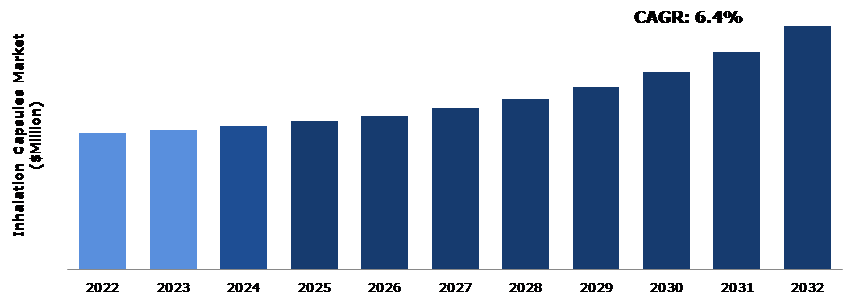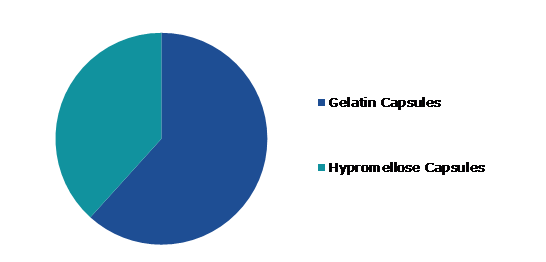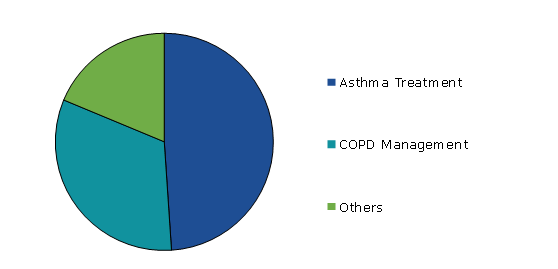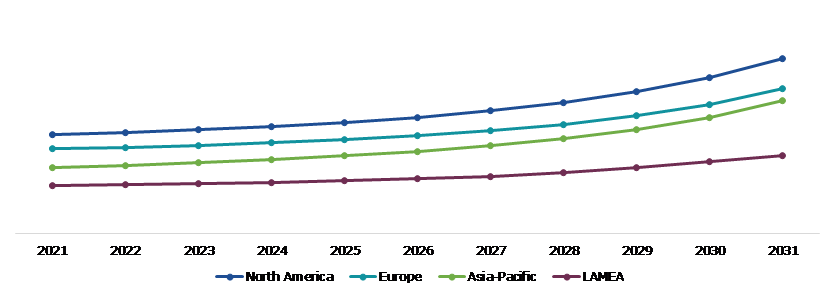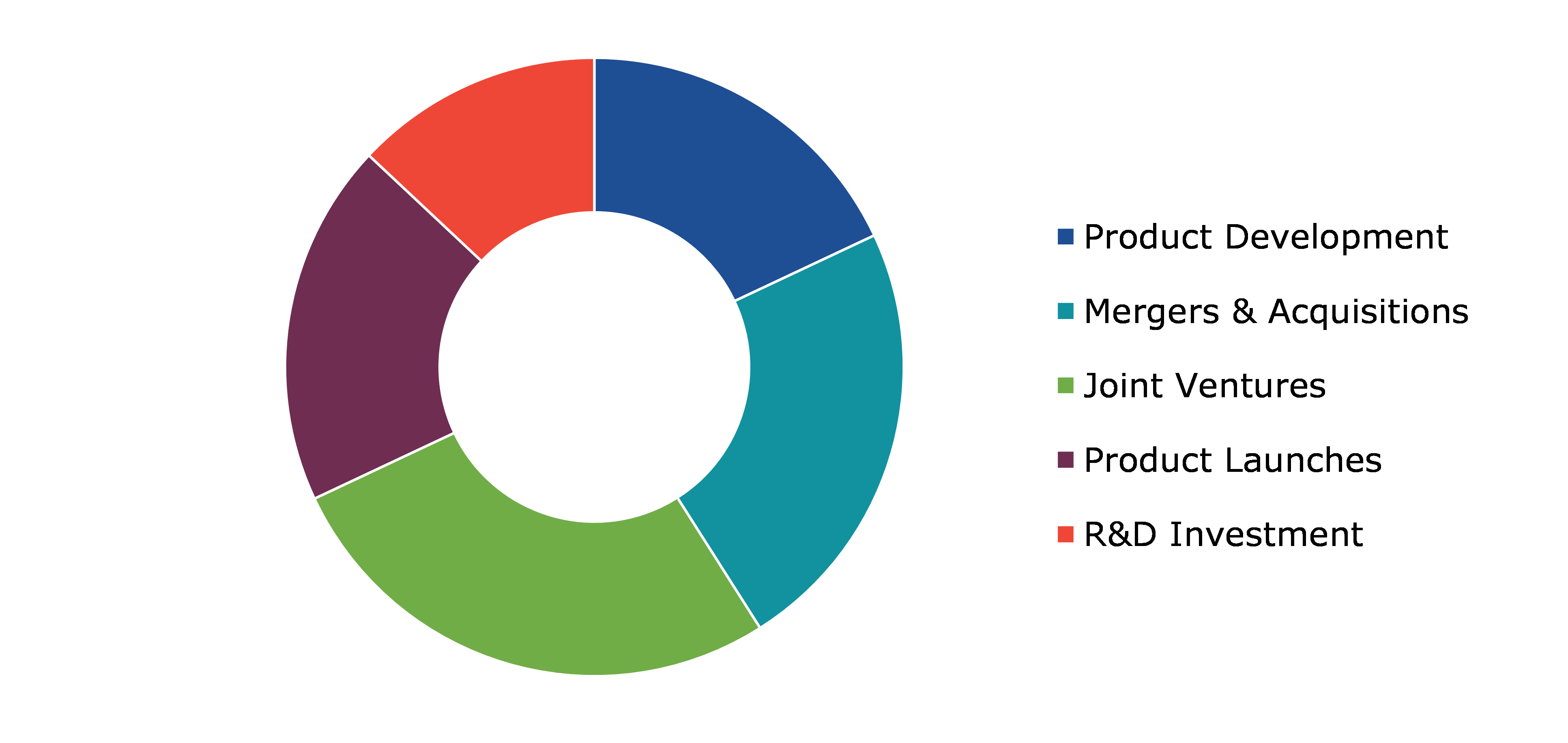Inhalation Capsules Market Report
RA09205
Inhalation Capsules Market by Type (Gelatin Capsules and Hypromellose Capsules), Application (Asthma Treatment, COPD Management, and Others), and Region (North America, Europe, Asia-Pacific, and LAMEA): Global Opportunity Analysis and Industry Forecast, 2023-2032
Inhalation Capsules Overview
The ability of inhalation capsules to deliver drugs directly to the lungs provides immediate and focused therapy for respiratory disorders. This tailored delivery approach reduces systemic adverse effects while increasing treatment effectiveness. Usually, the capsules are intended for use with specialized inhalation devices such as dry powder inhalers (DPIs) or metered-dose inhalers (MDIs). Inhalation capsules are emerging as a possible alternative as the pharmaceutical industry continues to investigate new and more effective methods of medication administration. The small powder is then enclosed in a shell, which protects it from environmental conditions while also ensuring optimal dispersion during inhalation. This thorough design procedure is essential for establishing uniform and repeatable dosage, which is an important element of any pharmaceutical product. Inhalation capsules have showed great potential in treating a variety of respiratory disorders. In the treatment of asthma, for example, inhalation capsules carry bronchodilators directly to the bronchioles, resulting in quick reduction of bronchoconstriction. Similarly, for COPD patients, inhalation capsules are an effective approach to administer anti-inflammatory drugs that lower airway inflammation and enhance lung function.
Global Inhalation Capsules Market Analysis
The global inhalation capsules market size was $822.4 million in 2022 and is predicted to grow with a CAGR of 6.4%, by generating a revenue of $1,464.9 million by 2032.
Source: Research Dive Analysis
Increasing Demand for Inhalation Capsules for the Treatment of Respiratory System to Drive the Market Growth
The remarkable effectiveness of medication administration obtained by inhalation is one of the primary driving reasons driving the demand for inhalation capsules. The respiratory system provides a direct and speedy route to the circulation of inhalation capsule, allowing for the commencement of action to take place immediately. This is particularly important for treating illnesses characterized by acute exacerbations, where immediate relief is critical. The lungs provide a large surface area for medication absorption, and the thin alveolar membranes allow therapeutic substances to enter the circulation quickly. Therefore, inhalation capsules provide a more immediate and direct pharmacological response than traditional oral administration, giving patients with faster relief and better overall results. The quick beginning of action improves the effectiveness of inhalation capsules. The medicine is administered directly to the lungs, resulting in a quicker therapeutic response as compared to other methods of administration. This quick onset is critical in emergency settings or for drugs that require immediate relief, such as bronchodilators for acute respiratory distress. Due to the quickness with which inhalation capsules work, they are able to control respiratory disorders characterized by sudden onset or attacks.
Complexity Of the Manufacturing Process to Restrain the Market Growth
One of the key barriers is the strict regulatory system that governs pharmaceutical goods, especially inhalation capsules. Regulatory bodies apply strict criteria and procedures to assure the safety, effectiveness, and quality of medications. Manufacturers need to follow Good Manufacturing Practices (GMP), which entails keeping exact control over every step of the production process. Compliance with these requirements involves significant expenditures in technology, equipment, and people training, adding to the total complexity of the production process. Inhalation capsules' sophisticated design and composition add to the intricacy. These capsules frequently include specialized materials, such as polymers, which must fulfil strict stability, compatibility, and biocompatibility standards. To achieve the optimal balance of these qualities, significant understanding in materials science and formulation chemistry is required. Manufacturers find difficulties obtaining and processing these components, as well as assuring uniformity and optimizing the encapsulation process to produce the necessary drug delivery profile. Medication dosage accuracy in inhalation capsules is critical for therapeutic effectiveness and patient safety. However, throughout the production process, attaining consistent and accurate dosage offers a significant barrier. Variability in particle size, density, and dispersion can lead to irregularities in medication delivery, which can lead to a detrimental effect on treatment success.
Changing Landscape of Biopharmaceuticals and Personalized Medicine to Drive Excellent Opportunities
One of the key elements driving potential in this landscape is the rapid advancement of biopharmaceutical R&D. The development of innovative biotechnological tools and processes has greatly improved capacity to design and manufacture sophisticated biopharmaceuticals that are customized to individual patient demands. Inhalation capsules provide a distinct benefit by distributing these biopharmaceuticals directly to the respiratory system, allowing for focused and efficient administration. Personalized medicine, which focuses on adapting treatments to unique patient characteristics, is projected to create growth opportunities in the pharmaceutical sector. In the context of inhalation capsules, the capacity to tailor medication compositions based on genetic, metabolic, and physiological characteristics represents a huge advantage. This individualized strategy not only improves treatment efficacy but also reduces unwanted effects, resulting in better patient outcomes. The incorporation of pharmacogenomics and biomarker identification into personalized medicine improves treatment methods for respiratory disorders, opening the path for more effective inhaled medicines.
Global Inhalation Capsules Market Share, by Type, 2022
Source: Research Dive Analysis
The gelatin capsules sub-segment accounted for the highest market share in 2022. Biocompatibility is one of the primary reasons behind the use of gelatin capsules in inhalation. The human body tolerates gelatin, which is a natural protein generated from collagen. This biocompatibility reduces the possibility of adverse reactions and allergic reactions, making gelatin capsules a safe and dependable choice for inhalation medication administration. The capacity of gelatin to breakdown quickly in the body guarantees effective medication absorption, resulting in a quicker beginning of action. Gelatin capsules are not only biocompatible, but they are also quite versatile. They are easily adaptable to a broad range of medication formulations, including dry powder inhalation (DPI) and other inhalable drugs. Gelatin capsules' versatility permits the inclusion of numerous medications, enabling pharmaceutical companies to design inhalation solutions customized to specific patient needs. Gelatin capsules function as a protective barrier for the encapsulated medicine, sheltering it from external factors such as moisture and light. This protection safeguards the active components' stability and effectiveness throughout time.
Global Inhalation Capsules Market Share, by Application, 2022
Source: Research Dive Analysis
The asthma treatment sub-segment accounted for the highest market share in 2022. One of the primary driving factors is the quick start of effect associated with inhalation capsules. The respiratory system provides an optimal pathway for drug absorption, resulting in a faster symptom reduction than oral treatments. This rapid reaction is essential during asthma episodes, where early intervention can save lives. Inhalation capsules provide a simple and practical mode of administration, increasing patient adherence to treatment regimens. Inhalers' simplicity of use and portability increase their likelihood of being integrated into everyday routines, resulting in consistent drug adherence and improved asthma treatment. Inhalation capsules allow treatment strategies to be tailored to each patients' severity and special demands. Healthcare practitioners can change the amount and frequency of inhaler usage, adjusting the treatment to improve asthma control while reducing the risk of overmedication.
Global Inhalation Capsules Market Size & Forecast, by Region, 2022-2032 ($Million)
Source: Research Dive Analysis
The North America inhalation capsules market generated the highest revenue in 2022. The rising frequency of respiratory disorders is one of the factors driving the rise in popularity of inhalation capsules in North America. Prevalence of asthma, chronic obstructive pulmonary disease (COPD), and other respiratory illnesses has increased in the region. The regulatory situation in North America has been critical in fostering the uptake of inhalation capsules. Regulatory authorities such as the U.S. Food and Drug Administration (FDA) and Health Canada have developed rules and procedures to assure the safety, effectiveness, and quality of inhalation devices and medicines. The strict regulatory standards help to build confidence between healthcare professionals and patients, creating a favorable environment for the development of inhalation medicines. The pharmaceutical market in North America is characterized by dynamic developments that impact the use of various medication delivery techniques. Inhalation capsules have grown in popularity due to shifting market dynamics such as an aging population, rising prevalence of respiratory disorders, and a greater emphasis on preventative treatment.
Competitive Scenario in the Global Inhalation Capsules Market
Diversification of product portfolios and mergers & acquisitions are common strategies followed by major market players. For instance, August 18, 2023, Lupin launched its generic tiotropium bromide inhalation powder capsule for the treatment of chronic obstructive pulmonary disease (COPD) in the U.S.
Source: Research Dive Analysis
Some of the leading inhalation capsules market players are Capsugel, Qualicaps, ACG Worldwide, Cipla, Novartis, AstraZeneca plc, Chiesi Farmaceutici S.p.A., Elpen S.A., Vectura Group Plc, and Boehringer Ingelheim GmbH.
| Aspect | Particulars |
| Historical Market Estimations | 2020-2021 |
| Base Year for Market Estimation | 2022 |
| Forecast Timeline for Market Projection | 2023-2032 |
| Geographical Scope | North America, Europe, Asia-Pacific, and LAMEA |
| Segmentation by Type |
|
| Segmentation by Application |
|
| Key Companies Profiled |
|
Q1. What is the size of the global inhalation capsules market?
A. The size of the global inhalation capsules market was $822.4 million in 2022 and is projected to reach $1,464.9 million by 2032.
Q2. Which are the major companies in the inhalation capsules market?
A. Capsugel, Qualicaps, ACG Worldwide, Cipla, Novartis, AstraZeneca plc, Chiesi Farmaceutici S.p.A., Elpen S.A., Vectura Group Plc, and Boehringer Ingelheim GmbH are some of the key players in the global inhalation capsules market.
Q3. Which region, among others, possesses greater investment opportunities in the future?
A. Asia-Pacific possesses great investment opportunities for investors in the future.
Q4. What will be the growth rate of the Asia-Pacific inhalation capsules market?
A. The Asia-Pacific inhalation capsules market is anticipated to grow at 7.6 % CAGR during the forecast period.
Q5. What are the strategies opted by the leading players in this market?
A. Diversification of product portfolios and mergers & acquisitions are the key strategies opted by the operating companies in this market.
Q6. Which companies are investing more on R&D practices?
A. Cipla and Novartis are the companies investing more on R&D activities for developing new products and technologies.
1. Research Methodology
1.1. Desk Research
1.2. Real time insights and validation
1.3. Forecast model
1.4. Assumptions and forecast parameters
1.5. Market size estimation
1.5.1. Top-down approach
1.5.2. Bottom-up approach
2. Report Scope
2.1. Market definition
2.2. Key objectives of the study
2.3. Report overview
2.4. Market segmentation
2.5. Overview of the impact of COVID-19 on global inhalation capsules market
3. Executive Summary
4. Market Overview
4.1. Introduction
4.2. Growth impact forces
4.2.1. Drivers
4.2.2. Restraints
4.2.3. Opportunities
4.3. Market value chain analysis
4.3.1. List of raw material suppliers
4.3.2. List of manufacturers
4.3.3. List of distributors
4.4. Innovation & sustainability matrices
4.4.1. Technology matrix
4.4.2. Regulatory matrix
4.5. Porter’s five forces analysis
4.5.1. Bargaining power of suppliers
4.5.2. Bargaining power of consumers
4.5.3. Threat of substitutes
4.5.4. Threat of new entrants
4.5.5. Competitive Rivalry Intensity
4.6. PESTLE analysis
4.6.1. Political
4.6.2. Economical
4.6.3. Social
4.6.4. Technological
4.6.5. Legal
4.6.6. Environmental
4.7. Impact of COVID-19 on inhalation capsules market
4.7.1. Pre-covid market scenario
4.7.2. Post-covid market scenario
5. Inhalation Capsules Market Analysis, By Type
5.1. Overview
5.2. Gelatin Capsules
5.2.1. Definition, key trends, growth factors, and opportunities
5.2.2. Market size analysis, by region, 2022-2032
5.2.3. Market share analysis, by country, 2022-2032
5.3. Hypromellose Capsules
5.3.1. Definition, key trends, growth factors, and opportunities
5.3.2. Market size analysis, by region, 2022-2032
5.3.3. Market share analysis, by country, 2022-2032
5.4. Research Dive Exclusive Insights
5.4.1. Market attractiveness
5.4.2. Competition heatmap
6. Inhalation Capsules Market Analysis, by Application
6.1. Overview
6.2. Asthma Treatment
6.2.1. Definition, key trends, growth factors, and opportunities
6.2.2. Market size analysis, by region, 2022-2032
6.2.3. Market share analysis, by country, 2022-2032
6.3. COPD Management
6.3.1. Definition, key trends, growth factors, and opportunities
6.3.2. Market size analysis, by region, 2022-2032
6.3.3. Market share analysis, by country, 2022-2032
6.4. Others
6.4.1. Definition, key trends, growth factors, and opportunities
6.4.2. Market size analysis, by region, 2022-2032
6.4.3. Market share analysis, by country, 2022-2032
6.5. Research Dive Exclusive Insights
6.5.1. Market attractiveness
6.5.2. Competition heatmap
7. Inhalation Capsules Market, by Region
7.1. North America
7.1.1. U.S.
7.1.1.1. Market size analysis, by Type, 2022-2032
7.1.1.2. Market size analysis, by Application, 2022-2032
7.1.2. Canada
7.1.2.1. Market size analysis, by Type, 2022-2032
7.1.2.2. Market size analysis, by Application, 2022-2032
7.1.3. Mexico
7.1.3.1. Market size analysis, by Type, 2022-2032
7.1.3.2. Market size analysis, by Application, 2022-2032
7.1.4. Research Dive Exclusive Insights
7.1.4.1. Market attractiveness
7.1.4.2. Competition heatmap
7.2. Europe
7.2.1. Germany
7.2.1.1. Market size analysis, by Type, 2022-2032
7.2.1.2. Market size analysis, by Application, 2022-2032
7.2.2. UK
7.2.2.1. Market size analysis, by Type, 2022-2032
7.2.2.2. Market size analysis, by Application, 2022-2032
7.2.3. France
7.2.3.1. Market size analysis, by Type, 2022-2032
7.2.3.2. Market size analysis, by Application, 2022-2032
7.2.4. Spain
7.2.4.1. Market size analysis, by Type, 2022-2032
7.2.4.2. Market size analysis, by Application, 2022-2032
7.2.5. Italy
7.2.5.1. Market size analysis, by Type, 2022-2032
7.2.5.2. Market size analysis, by Application, 2022-2032
7.2.6. Rest of Europe
7.2.6.1. Market size analysis, by Type, 2022-2032
7.2.6.2. Market size analysis, by Application, 2022-2032
7.2.7. Research Dive Exclusive Insights
7.2.7.1. Market attractiveness
7.2.7.2. Competition heatmap
7.3. Asia-Pacific
7.3.1. China
7.3.1.1. Market size analysis, by Type, 2022-2032
7.3.1.2. Market size analysis, by Application, 2022-2032
7.3.2. Japan
7.3.2.1. Market size analysis, by Type, 2022-2032
7.3.2.2. Market size analysis, by Application, 2022-2032
7.3.3. India
7.3.3.1. Market size analysis, by Type, 2022-2032
7.3.3.2. Market size analysis, by Application, 2022-2032
7.3.4. Australia
7.3.4.1. Market size analysis, by Type, 2022-2032
7.3.4.2. Market size analysis, by Application, 2022-2032
7.3.5. Indonesia
7.3.5.1. Market size analysis, by Type, 2022-2032
7.3.5.2. Market size analysis, by Application, 2022-2032
7.3.6. Rest of Asia-Pacific
7.3.6.1. Market size analysis, by Type, 2022-2032
7.3.6.2. Market size analysis, by Application, 2022-2032
7.3.7. Research Dive Exclusive Insights
7.3.7.1. Market attractiveness
7.3.7.2. Competition heatmap
7.4. LAMEA
7.4.1. Brazil
7.4.1.1. Market size analysis, by Type, 2022-2032
7.4.1.2. Market size analysis, by Application, 2022-2032
7.4.2. UAE
7.4.2.1. Market size analysis, by Type, 2022-2032
7.4.2.2. Market size analysis, by Application, 2022-2032
7.4.3. South Africa
7.4.3.1. Market size analysis, by Type, 2022-2032
7.4.3.2. Market size analysis, by Application, 2022-2032
7.4.4. Argentina
7.4.4.1. Market size analysis, by Type, 2022-2032
7.4.4.2. Market size analysis, by Application, 2022-2032
7.4.5. Rest of LAMEA
7.4.5.1. Market size analysis, by Type, 2022-2032
7.4.5.2. Market size analysis, by Application, 2022-2032
7.4.6. Research Dive Exclusive Insights
7.4.6.1. Market attractiveness
7.4.6.2. Competition heatmap
8. Competitive Landscape
8.1. Top winning strategies, 2022
8.1.1. By strategy
8.1.2. By year
8.2. Strategic overview
8.3. Market share analysis, 2022
9. Company Profiles
9.1. Capsugel
9.1.1. Overview
9.1.2. Business segments
9.1.3. Product portfolio
9.1.4. Financial performance
9.1.5. Recent developments
9.1.6. SWOT analysis
9.2. Qualicaps
9.2.1. Overview
9.2.2. Business segments
9.2.3. Product portfolio
9.2.4. Financial performance
9.2.5. Recent developments
9.2.6. SWOT analysis
9.3. ACG Worldwide
9.3.1. Overview
9.3.2. Business segments
9.3.3. Product portfolio
9.3.4. Financial performance
9.3.5. Recent developments
9.3.6. SWOT analysis
9.4. Cipla
9.4.1. Overview
9.4.2. Business segments
9.4.3. Product portfolio
9.4.4. Financial performance
9.4.5. Recent developments
9.4.6. SWOT analysis
9.5. Novartis
9.5.1. Overview
9.5.2. Business segments
9.5.3. Product portfolio
9.5.4. Financial performance
9.5.5. Recent developments
9.5.6. SWOT analysis
9.6. AstraZeneca plc
9.6.1. Overview
9.6.2. Business segments
9.6.3. Product portfolio
9.6.4. Financial performance
9.6.5. Recent developments
9.6.6. SWOT analysis
9.7. Chiesi Farmaceutici S.p.A.
9.7.1. Overview
9.7.2. Business segments
9.7.3. Product portfolio
9.7.4. Financial performance
9.7.5. Recent developments
9.7.6. SWOT analysis
9.8. Elpen S.A
9.8.1. Overview
9.8.2. Business segments
9.8.3. Product portfolio
9.8.4. Financial performance
9.8.5. Recent developments
9.8.6. SWOT analysis
9.9. Vectura Group Plc
9.9.1. Overview
9.9.2. Business segments
9.9.3. Product portfolio
9.9.4. Financial performance
9.9.5. Recent developments
9.9.6. SWOT analysis
9.10. Boehringer Ingelheim GmbH
9.10.1. Overview
9.10.2. Business segments
9.10.3. Product portfolio
9.10.4. Financial performance
9.10.5. Recent developments
9.10.6. SWOT analysis
Personalize this research
- Triangulate with your own data
- Request your format and definition
- Get a deeper dive on a specific application, geography, customer or competitor
- + 1-888-961-4454 Toll - Free
- support@researchdive.com

